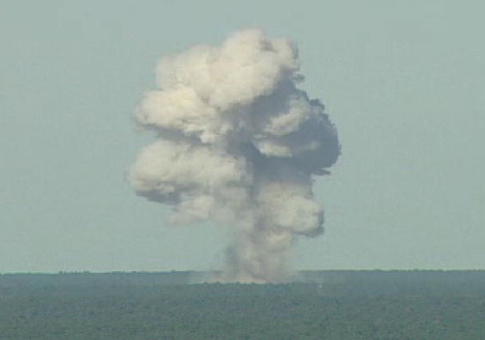Clocking in at 30 feet long and 22,000 pounds, the MOAB, or Massive Ordnance Air Blast, is one of the largest bombs in the world. On Thursday, it was used in combat for the first time against a terrorist stronghold in eastern Afghanistan near the Pakistani border.
The MOAB, which is nicknamed "the Mother of All Bombs," is so large it can only be carried on a C-130 Hercules and pushed out of the back hatch mid-flight. The bomb is designed to explode in midair and has a blast radius that can stretch out a mile. It is designed in a way that allows the concussion of the blast to penetrate tunnels with enough force to kill the people inside.
The bomb was dropped on an ISIS-Khorasan tunnel complex located in Nagarhar Province.
General John Nicholson, who commands US forces in Afghanistan, described the MOAB as the right bomb for the job.
"As ISIS-K's losses have mounted, they are using IEDs, bunkers, and tunnels to thicken their defense," Gen. Nicholson said in a statement. "This is the right munition to reduce these obstacles and maintain the momentum of our offensive against ISIS-K."
The MOAB was originally developed in the lead up to Operation Iraqi Freedom. It was intended to be used in the "Shock and Awe" phase of the invasion of Saddam Hussein's Iraq. Then-Secretary of Defense Donald H. Rumsfeld said the MOAB was meant to send a message to the Iraqi military.
"The goal is to have the capabilities of the coalition so clear and so obvious that there is an enormous disincentive for the Iraqi military to fight against the coalition," Rumsfeld said after a test of the MOAB on March 11, 2003.
The speed of the invasion and lack of substantial resistance prevented the MOAB from seeing battle during Operation Iraqi Freedom.
The MOAB's first use in Afghanistan comes a week after an attack in Nangarhar Province, which killed Staff Sgt. Mark R. de Alencar. USFOR-A, which oversees U.S. Forces in Afghanistan, said in a statement the bombing mission was "designed to minimize the risk to Afghan and U.S. forces conducting clearing operations in the area while maximizing the destruction of ISIS-K fighters and facilities."
They further promised to completely destroy ISIS in Afghanistan.
"U.S. forces will continue offensive operations until ISIS-K is destroyed in Afghanistan," USFOR-A said.
